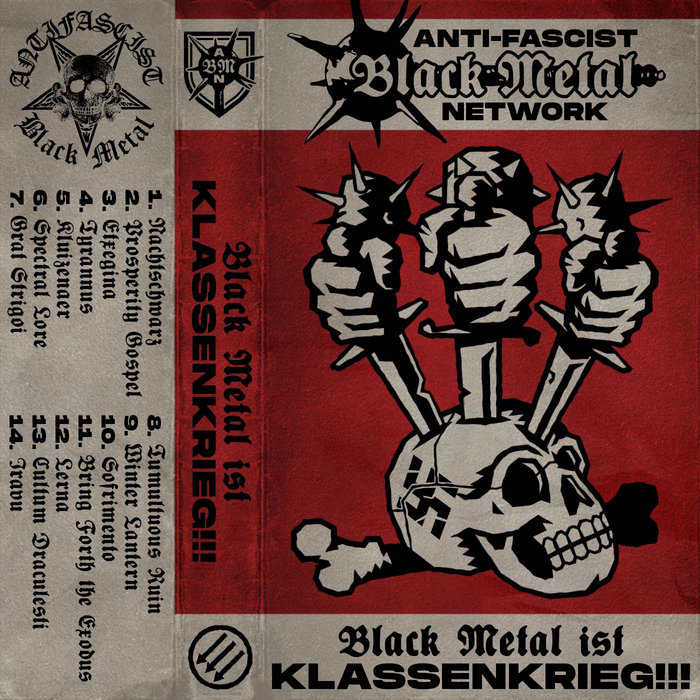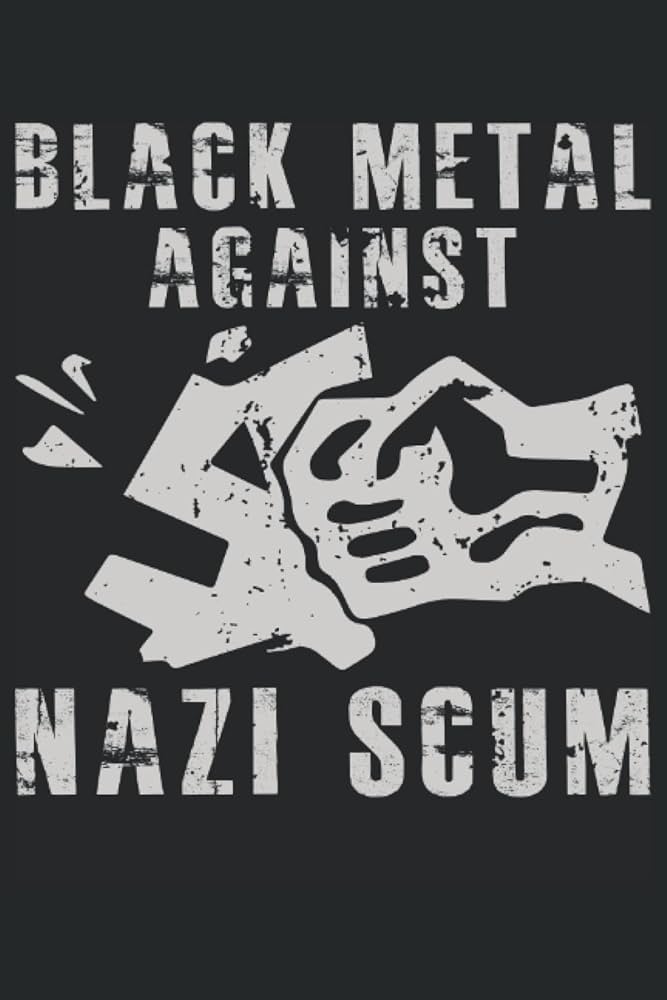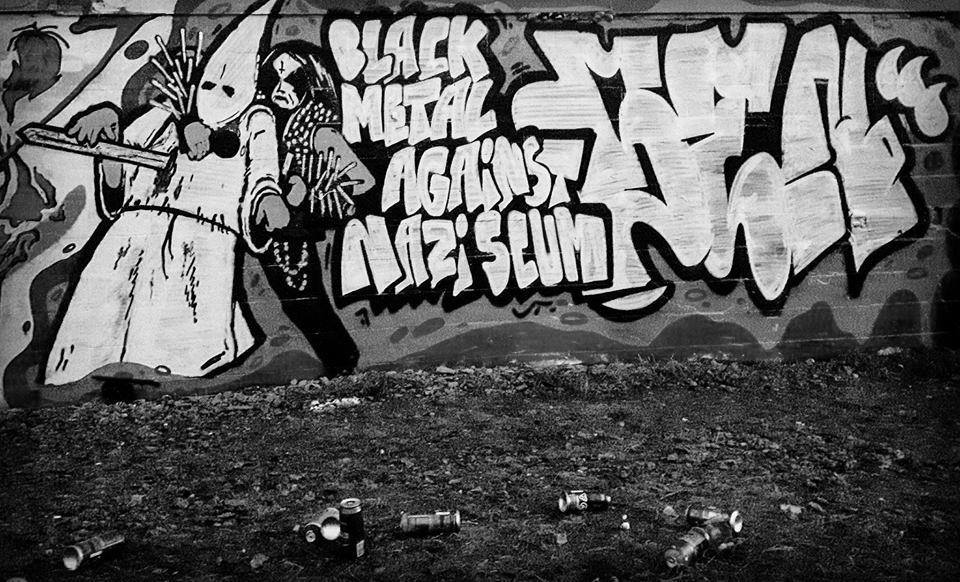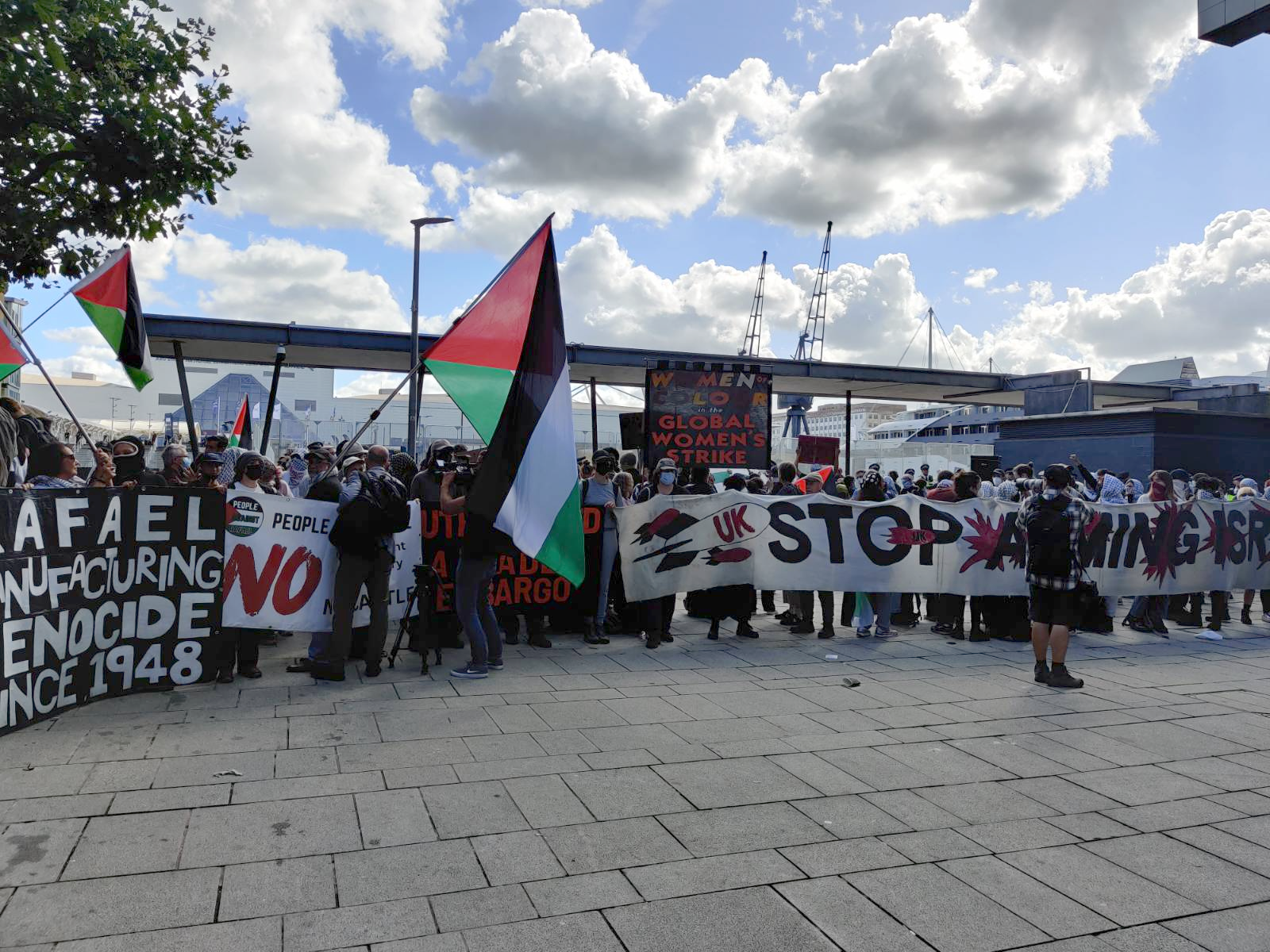Black Metal still has a far right problem—here are some tools to fight back
Despite what some fans may claim, far right political organizing in the extreme metal scene was not a flash-in-the-pan phenomenon that ended in the 1990s. In parallel with the global rise of fascism over the past decade, National Socialist Black Metal (NSBM) has become more prominent and recognized within local and international metal scenes and communities. In tandem, it becomes increasingly important to understand and recognise NSBM bands, alongside equivalents such as hatecore and Rock Against Communism (RAC), how they convey their ideologies, and how they interact with the broader global metal ecosystem.
Given my personal research focus, the two case studies that I present – Ignis Gehenna and Sanguinary Misanthropia – are both Australian bands, but they are part of international networks and resisting them offers lessons for other struggles. In particular, both bands have links to the Temple of THEM (ToT), the Australian “nexion” of the increasingly infamous Order of the Nine Angles (O9A), an occult accelerationist organization linked to myriad arrests in the USA and UK. As with any aspect of the far-right, there are layers of irony enmeshed with the naturally impenetrable esoteric language that exist to provide deniability for those involved. Nevertheless, there is a clear intent for this material to promote violence and hate.
This article will briefly summarise the history of NSBM, some contemporary case studies based on my own research in the Australian metal scene, and conclude by giving some thoughts as to what may be done to combat this in local metal scenes.
A brief history
Understanding NSBM requires understanding its parent genre, black metal. Beginning in in the 1980s, black metal initially connoted any heavy metal music that had an explicit and sustained Satanic focus, inspired by UK band Venom’s 1982 album Black Metal. During the 1990s, black metal acquired specific sonic characteristics that marked it as a distinct sub-genre, largely based on the characteristics of the infamous Norwegian black metal scene. A low-fidelity production style; distorted, tremolo-picked riffs; and a high-pitched, howling vocal style joined the Satanic lyrics and visual features like scribbled band logos and “corpse-paint” make-up, setting the broad template for black metal that has been iterated on around the world in the decades since. Black metal is intentionally as inaccessible and esoteric as possible, rejecting the (comparatively) wider commercial success of more melodic and rhythmic metal subgenres in favour of a grim and “trve kvlt” aesthetic.
NSBM has been a notable aspect of the genre since its codification in the 1990s Norgwegian scene, largely through the efforts of Kristian “Varg” Vikernes and his one-man-band, Burzum. Vikernes’s infamous arsons and murders are not the main focus of this article, but rather how his increasing affiliation with national socialist ideas manifested in his obsession with a bastardised pseudo-Norse occultism. These would gradually metastasize into what Vikernes calls “Odalism”, a fusion of esoteric fascist ideas with Wotanism. Odalism was propagated through Burzum, publications such as Vargsmal, and the Norwegian Heathen Front, which Vikernes founded.
In parallel, other bands such as Absurd in Germany were building a broader NSBM network. Hendrik Mӧbus, founder of Absurd and record label Darker Than Black, mirrored Vikernes, both in turning to the far right while imprisoned for murder, and in founding the German Heathen Front, though he had wider international connections to neo-Nazis such as William Luther Pierce. The notorious neo-Nazi music festival, Asgardsrei, takes its name from the Absurd album of the same name, and is a notable for its connections and funding to a range of far right organisations in Europe.
Absurd’s first Australian connection was the band Spear of Longinus. From 1995’s Nazi Occult Metal to more recent releases such as 2007’s …And the Swastikalotus, the band have produced a consistent output that does exactly what it says on the tin – a mixture of far-right politics and esoteric occultism, this time with elements drawn from the works of Savitri Devi and Miguel Serrano. Despite their international recognition in NSBM circles, the members of Spear of Longinus continue to have numerous ties to other bands in the Australian scene.
These bands are not the full extent of NSBM globally (Poland’s Graveland, Russia’s M8l8th, and Finnish musician Mikko Aspa are dishonourable mentions in the field) but they establish some points of commonality: the centrality of the musical genre, the mixture of esoteric fascism and other types of occultism and/or satanism, and the tangible connections between “just music” and political activity. Over the years, NSBM has met with resistance in every country, with a growing anti-fascist presence in the scene and numerous Red and Anarchist Black Metal (RABM) bands and collaborations.
Modern Australian NSBM
Ignis Gehenna, a Tasmania band largely driven by musician Aldhamme, make extensive use of mainstream occult nazi symbolism (such as the black sun, seen in the band’s promotional material) and that specific to the ToT, such as the “Thrasz”, a loosely modified swastika. This modified black sun is a significant image to be associated with the band, as it links them to Waldkampf, a now-defunct far-right group also based in Tasmania, masquerading as a wilderness fitness group. Once actually in the wilderness, nazi symbology and occult ritual became more prominent in Waldkampf’s behaviour.
Lyrical allusions to nazi ideology can also be seen in Ignis Gehenna’s music. Their song “Baleful Scarlet Star” contains the following lyrics:

Being unto becoming; becoming unto being
As a deep mirror seen as the black sun
12 Sig runes, sharp as knives
Cutting away at the
Sedimentary rock of a
Moribund, Nazarene enthralled aeon!
…
The scarlet star falls in a whorl of lust
Tending the fields of Judea with blazing white phosphorus
The specific mention of “12 Sig runes” making up the black sun is significant, as this was the specific design of the black sun used by the Nazi Schutzstaffel (SS), the elite corps of the Nazi Party responsible for such things as the administration of concentration camps. Note as well that the “scarlet star” of the song’s title is portrayed as a white phosphorus bomb over Judea, combining allusions to fire-based destruction of the Jewish people (and a more literal definition of “holocaust”) with direct threat.
A similar example is found in Sanguinary Misanthropia, another one-man project helmed by “Frater Kafyrfos”. Karfyrfos espouses an ideology that he calls “Diabolical Gnosticism”, itself closely related to ToT and O9A. Diabolical Gnosticism is a fusion of these philosophies with strains of broader esoteric satanism, such as the Temple of the Black Light/Misanthropic Luciferian Order (which will be familiar to fans of the Swedish black metal band Dissection and Jon Nӧdtveidt).
By Kafyrfos’ own admission, his work draws extensively on the symbology of national socialism, and features extensive reference to the wider beliefs of Diabolical Gnosticism. For some songs, such as “Tetraskelion”, this reference is quite obvious, a tetraskelion being another name for a swastika (playing off the Celtic triskelion). The lyrics directly use the term “hakenkreuz” (hooked cross) as an alternative to tetraskelion. Hakenkreuz is the proper name for what is usually called a swastika when used by the nazis. Others draw on communicate similar approaches to those of Ignis Gehenna, such as the lyrics to “Of Death and Genocide” that envision “a sky clouded black/ with Judaic ash”.
In other places, any semblance of obfuscation is removed. While Karfyrfos contends in the interview mentioned above that Sanguinary Misanthropia is too misanthropic to be explicitly political, he immediately goes to great lengths to note that this would be despite his personal political beliefs. He then waxes lyrical about his admiration for national socialism and his agreement with “physically destroying the sub/human [sic] enemies to give rise to intelligent beings greater than humanity”. Notably, the official Facebook page and merchandise produced by the band strangely missed the memo in terms of apoliticism, with the image below demonstrating several Nazi symbols in these products.

Given the content of the lyrics, merchandise, and interviews, this claim that Sanguinary Misanthropia are apolitical should be understood as only the thinnest of attempts at constructing deniability for the project.
Beyond the band providing a platform for the spread of his ideologies and links to his written works on Diabolical Gnosticism, Kafyrfos also notes that his band “active[ly] encourages our fanatics to take up our message of hate and unbelief… thus shall we purge the Blood of sub/humanity”. Given the connections between both bands and ToT, some of ToT’s writings are relevant here as well. Specifically, precepts of the ToT encourage their followers to “Copy… Sinister music [i.e. music that communicates their beliefs] on to cyber sites,” “Donate time, space, or energy for a Sinister band,” “Keep tabs on death metal… and [other music] scenes – watch for recruits”. Together, these show a consistent drive to use alternative music scenes, especially metal, as a place to spread their ideology and find recruits.
This is especially concerning considering the recent trend of lone wolf terrorist attacks, such as the Christchurch Mosque shootings in 2019. The shooter’s manifesto, and that of Anders Brevik, contain references to nazi occultist ideas. Furthermore, the trend towards stochastic terrorism, where the lone wolf attacker is wound up by one or more ideologues to commit their attack, adds to the danger of NSBM bands. As with many other far-right personalities, these bands are not specifically telling someone to go out and attack a specific group of people—but they are producing a consistent body of work about how great it would be if somebody did just that. In this light, Kafyrfos’ instructions to “take up the message of hate” and “purge subhumans” and Aldhamme’s visions of white phosphorous over Judea become more concerning.
International Connections
While these bands are located in Australia, geographical distance does not mean cultural isolation, nor the ability to move around. Considering again the Christchurch mosque shooter, not only was he Australian, but had been travelling the world, and contacting various far right organisations, before planning his attack. In the internet age, it is even easier for connections between groups around the world to grow and be used, especially when considering how much of movements like the alt-right grew out of online imageboards such as 4chan.
Such links are apparent in both bands. Both are directly linked to an international network of nexions of the O9A through the ToT, the O9A itself being an organization based in the UK. With ties from Ignis Gehenna to organisations like Waldkampf, there are links through here to the broader Operation Werewolf neo-Nazi fitness movement, its founder Paul Waggener, and its parent organization the Wolves of Vinland neo-Nazi cult in the USA.
The broader history of NSBM demonstrates this as well, from the parallel Norse and German Heathen Fronts tied to Burzum and Abusrd respectively, to the aforementioned Asgardrei festival with its links to funding far-right paramilitary groups like the Azov Battalion. In some cases, these international networks sit barely below the surface of the mainstream scene. Mӧbus’ Darker than Black record label remains active and prominent in underground black metal scenes. Burzum and Vikernes retain a near legendary status with many metal fans due to their role within the 1990s Norwegian black metal scene. Most recently, Burzum is even crossing over into wider music awareness, especially since being repped by Kayne West of all people.
What do you do with a scene full of Nazis?
We then come to the question of “what do we do about all of this?” The encouraging part is that antifascism is not new, and there are nearly a century’s worth of tactics to learn from around the world. I’m not going to pretend that I have all the solutions to this issue, nor that these are all my ideas, but, in my experience, these recommendations have been effective. In practice, pushing back against NSBM is more or less the same as any other type of antifascist activity, and the same tactics are useful.
The main tactic is to raise the social and emotional cost of having NSBM bands be a part of the scene. In essence, affiliation with NSBM should be so toxic to its band members that the consequences of espousing far-right ideals outweigh the benefits. It should become so difficult for NSBM bands to engage with the mainstream scene because of how hard the pushback is that NSBM bands simply give up. Deplatforming, exclusion from mainstream scenes, and general ostricisation are all useful means of doing this. As it becomes harder for NSBM bands to engage in the mainstream scene, the band members will be forced to choose either to abandon NSBM, or abandon the scene.
The first step is to think about what you are prepared to do as part of your activism. Everyone has different levels of comfort with direct action, and organising with fellow antifascist scene members can be a great way to have different people fill different roles. Contacting venues personally may be too far for you, but you might be more comfortable doing research and intel. Or you may choose instead to heckle the guitarist of a local band who persistently wears a Burzum shirt when playing. Every little bit helps, and you may find you become more comfortable with what you can do as you progress.

Whatever level of participation you choose, having good, accurate, current information on local bands is essential, even if you’re just a punter. Look at what bands are playing locally, and if something causes your fash senses to tingle, research it. Sometimes, it might just be metal edginess or extremity, but often deeper digging finds useful material. Look at logos, imagery, band names, interviews, and song titles/lyrics. Are there common dogwhistles (e.g. 14, 88, triple parentheses, etc.) being used? Are there common neo-Nazi symbols (swastika, black sun, fasces, Totenkopf/death’s head) being used?
Going deeper, interviews with band members, pseudonyms, related projects, and record labels can all be useful to look at to see what circles a given band or band member moves in. Sometimes, bands might not be super overt about their affiliations or political beliefs, and you might end up with a band in the grey area that is usually referred to as being “sketch” – not necessarily a full-blown NSBM band, but definitely in the same ballpark. Everyone has a different threshold for where the line is for sketchy bands that warrants withdrawal of support, so you will likely need to exercise some personal judgement here.
Once you’ve identified an NSBM band active in your local scene, it can usually be worth contacting the venue that they play at and/or the promoter of the gig. In my experience, most venue owners have not investigated the bands playing at their venues in much detail and rely on promoters to vet the performers. Venue owners are usually very unwilling to be associated with NSBM and, in my experience, are more responsive to removing NSBM bands from events. Promoters can vary, but are generally aware of who they are working with. I have found that most promoters working in the mainstream metal scene are not particularly interested in the politics of the bands that they work with (and often actively avoid thinking about it if possible, see Keith Kahn-Harris’ concept of reflexive anti-reflexivity for more on this) and have a stronger ideological loyalty to their bottom line than they do any political philosophy. That said, deplatforming NSBM bands can often cause a gig or tour to tank altogether, so be prepared to become unpopular with promoters if you regularly push back against NSBM in your local scene.
If you choose to contact venues, consider your personal safety, and that of people you might be working with. Even if you request anonymity from an owner or promoter, chances are they will still discuss you by name when they go back to the NSBM band in question to ask them about their content. The easiest way to mitigate this is to be anonymous with the venue in the first place, though this is less persuasive than being willing to put your name on what you say. Given my academic research in this area already has my name attached, and is a fairly narrow field, I have elected to use my name (and title) when contacting people regarding NSBM, but that has certainly attracted negative attention in the past. This is your choice to make, and again, consider your personal safety and relative privilege (or lack thereof) when doing this; it is much easier for me to put my name to this work as a straight, white, cis, male than it would be for many other marginalized individuals.

If you are active in the local scene as a band or musician, you have the power to affect this too. Refuse to play with NSBM bands. Don’t collaborate with people who have unapologetically associated with NSBM bands in the past. Openly state that there is no place for NSBM in the local scene. As a punter in the scene, don’t buy music or merch for NSBM bands. If you can’t get their gigs cancelled or these bands removed, refuse to attend and encourage others to as well. Loathe as I am to work within the confines of capitalist systems to achieve our ends, it is unlikely that venues owners and promoters are deeply committed leftists, so sometimes you need to simply make it not worthwhile for them to book NSBM bands. Raising the cost – be it social, financial, or emotional – to performing in an NSBM band means that fewer people will do it and it will become increasingly isolated. Lots of NSBM-only festivals and gigs already happen in “undisclosed locations” (read: “my mate’s shed with 4 other people in attendance”), and it is unlikely that these gigs will be easily stopped. Accordingly, the local scene is where antifascist efforts should be concentrated, so that the only option for NSBM bands is to perform in someone’s shed to an ever-dwindling group of supporters.
Don’t think that you need to do all this alone. Like most types of leftist organising, solidarity and collective power are some of your most effective tools. Look out for local antifascists of any kind in your local and work together with them, even if they are not metal-specific. Get friends in the scene who are also sick of nazi bands to work with you. Build a network of likeminded people that will support you locally, nationally, and globally. That may sound intimidating, but I have found that consistent activity as an antifascist comes with consistent support from like-minded folks, and I had organically grown a robust network across the country (and increasingly internationally) quite quickly. NSBM and other far-right groups make effective use of online networks, and you should as well. Use Facebook groups, telegram channels, subreddits, whatever – any place to gather and share information is useful. This is also a case where effective organisation may mean overlooking some smaller ideological differences between flavours of leftist beliefs for the sake of antifascist action. This does not mean to completely drop any standards for who you work with (and, in the metal scene it is worth keeping an eye out for centrist and liberal bands who use antifascism as an aesthetic and marketing gimmick but get very upset as soon as actual action is required on their part), but that you should make use of whoever you can that is committed and trustworthy in your local area.

On the off chance that the reader is not a leftist, has read this far in the article, and is still on the fence about doing something about all these nazis, allow me to make one final appeal. We know from the history of alternative music scenes in general that if they cannot regulate themselves, they will be regulated externally, usually in the forms of cops turning up to gigs or persistent bad reputations for a genre that kill the scene when venues won’t host any metal gig for fear of NSBM. Australia has a pertinent example of this, with the charity festival Metal for the Brain, a hallmark of Australian metal in the 2000s, was cancelled when all local venues refused to host the gig purely based on the reputation of metal bands. Nothing had happened to cause this reputation (and local gig security commonly cited metal crowds as the easiest to manage), but once a negative reputation entered the minds of local venues, nothing could be done.
If you love metal music, as I do, then you have a responsibility to keep your scene safe. You probably have friends that are trans, gay, not white, or not male – they are all at varying levels of real risk from NSBM bands and the far right. Calls to violence happen when far-right bands play even mainstream gigs. NSBM has no place in metal, and it is up those of us committed to our scenes to push back against it. Otherwise, before too long, there won’t be much of a scene to care about.
~ Benjamin Hiller








